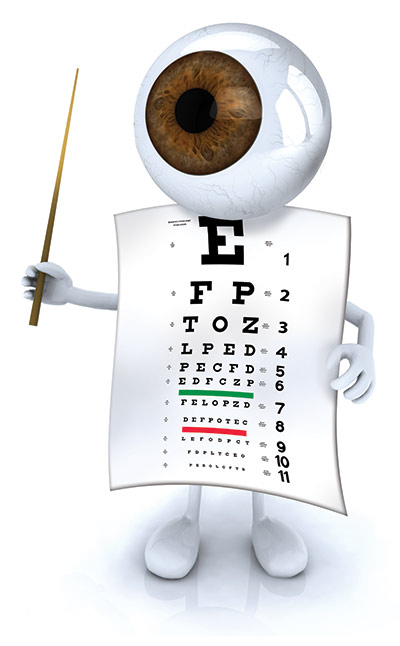
By Sara Bonizio
As marketing and community relations manager for our family-owned optometric practices, my office is filled with everything from easels, flyers, old photo books filled with “Throwback Thursday”-worthy company memories, boxes of promotional giveaways, and more. Here’s a glimpse into my Events Packing List:
- Eye Health Educational Materials
- Branded Signage & Giveaways
- Handheld Autorefractor
- Printer
- “Minion” Costume
Over the past five years managing community outreach, I have refined the model to reduce costs and maximize reach, while earning the respect of local residents, businesses and nonprofits (as well as press and social media coverage). During this time, certain promotional tactics have proved to generate a better return than others, but there is one constant: providing health care services of value to participants will almost always generate goodwill toward your practice—and if the right tools are used, these services can be a conduit to new patient acquisition.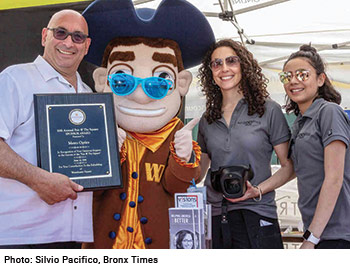
My team and I participate in three different kinds of events: B2B networking events, where we connect with other small businesses and nonprofits; hosted events, where we partner with one or more companies to provide vision testing and/or education with a complementary retail experience (e.g., fashion and beauty, such as when we partnered with a local brow bar to provide eyewear styling along with discounted eyebrow shapings); and community events, which include vision screening where time and facilities allow. Of these, the events where we perform vision screenings along with eye health education and access to eyecare resources are the most effective at encouraging potential new patients to request an appointment, visit one of our locations, or at least, check us out online, because they walk away with a clear call to action.
For the past several years, our team has used the SPOT Vision Screener (manufactured by Welch Allyn) to provide screenings at hundreds of free events in our main service area, the New York City borough of the Bronx—events that are open to the public as well as events I arrange for designated attendees such as nonprofit program participants, or employees of a fellow small business.
THE PERSONAL CONNECTION
Whenever someone consents to a screening, they are self-selecting to engage with our outreach team and usually much more receptive to our efforts to educate about good eyecare habits. We know we’ll have at least a few minutes to converse with subjects about various matters (in addition to the screening results), such as the main goal of facilitating a comprehensive annual eye exam to yield a complete picture of both vision and eye health; protecting eyes with quality UV-blocking sunglasses all year-round, as well as blue light-filtering lenses to combat digital eye strain; and protective sport eyewear for kids and adults.
The ability to provide a personalized, tangible screening result (printed using a lightweight Wi-Fi printer) branded with our company logo, website and phone number is a key element of the process. When visitors to our screening booth/room leave, they walk out with autorefraction results, a brochure about the importance of an annual comprehensive eye exam, other information about keeping eyes healthy, and an eyewear savings card. (And the kids always get an eyeball eraser or other toy, while the adults usually pocket a new microfiber cleaning cloth or other promotional item. Pens, for some reason, are still a very popular giveaway!)
Something to keep in mind: Lighting conditions may affect certain tools’ functionality. I can’t just show up with a table, screener, printer, flyers and swag on the day of—I always need to coordinate closely with those who request Metro Optics vision screenings, and often perform a pre-event site visit to ensure that there is a suitable screening room available on their premises that can get completely dark. If not, I need to make arrangements to erect a “pop-up” screening booth fashioned together with detachable PVC piping and blackout curtains. While this is in theory a good solution that would allow us to take our services nearly anywhere, it does require additional muscle to erect, as well as a sturdy structure to anchor it to (and we also have to lug our heavy portable power source—also great for jump-starting your car if need be!). So wherever possible, I ask for access to a dedicated room for screenings, where darkness is achievable by flicking the “off” switch, and there is almost always an electrical outlet nearby (or within reach of my super-sized extension cord).
As mentioned, I have been using the SPOT/PediaVision autorefractor to perform screenings during our outreach activities. Let’s take a look at this and other technologies on the market that are being used to perform eye tests outside of, or as a supplement to, the traditional “exam chair” setting.
(Each company was contacted and invited to submit a statement about their technologies as well as their overall mission and vision for how their tools will serve the market).
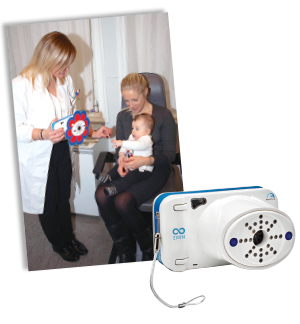
The 2WIN by ADAPTICA is a mobile tool that measures binocular refraction in real life vision conditions to detect refractive errors, eye abnormalities and vision problems measuring in the range of -15D to +15D, as well as dynamic pupil response to programmable light stimulations; it also has a lens centering application.
“We realize devices for the detection of refractive errors and visual defects, and solutions for the diagnosis and correction in a simple, smart and mobile way,” says Adaptica spokesperson Valentina Camporese. “Our vision is to revolutionize the vision screening process and the possible corrective prescription, making it globally available, accelerating it and maximizing diagnosis effectiveness. We want to contribute to the improvement of people’s lives in terms of better vision, productivity and well-being for everyone, everywhere.”
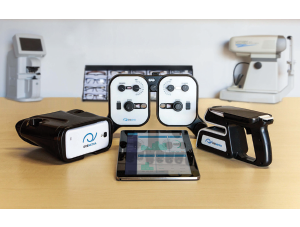
EYENETRA tools capitalize on ease, mobility and entertainment to create a convenient boutique experience while vision testing. The system uses a self-test mobile [auto]refraction tool powered by a smartphone for mobile eye diagnostics or vision screenings via a series of game-like interactions in a virtual-reality environment, as well as an automated lensometer and a handheld phoropter.
According to Greg Balla, founder: “EyeNetra is a medical technology company that aims to empower the eyecare professional. We supply the tools and technology, and ECPs possess the desire and the know-how. Together we can deliver smarter solutions that make the most impact.” The company promotes creating a relaxed environment to use their mobile tools within your existing office/retail space, or in a pop-up location outside off-site to create a unique vision testing experience for patients/customers.
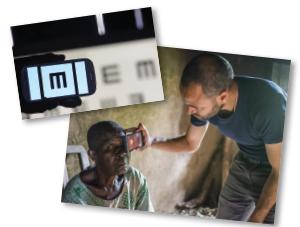
PEEK SOLUTIONS is a social enterprise “built on smartphone technology, [which] includes apps and hardware enabling eye checks to be conducted in homes, communities and schools. “Peek’s mission is to bring better vision and health to everybody, especially the millions of people living in remote or under-resourced regions who needlessly lose their sight because they are invisible to eye health services,” says Dr. Andrew Bastawrous, CEO. “Peek Acuity offers a clinically-validated smartphone-based refraction check, and this functionality is embedded into Peek Capture, our wider software system. Peek Capture enables non-specialists to perform vision screening using smartphones in schools and communities, freeing up scarce specialist resources, and allows service managers to understand patients’ journeys through the referral pathway. It also prompts caregivers, teachers and community leaders with text message reminders, improving attendance at follow-up appointments. We’re currently working with our partners to roll out our smartphone-based eye health screening systems in several different countries, including Botswana, Kenya and Pakistan. We’re working with some incredible partners, including optometrist and ophthalmologist associations, NGOs, funders and governments, and we’re very excited about the progress we expect to make in the coming months.”
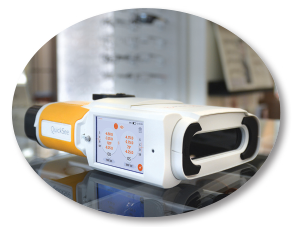
PLENOPTIKA, a social enterprise spun out of the Massachusetts Institute of Technology, was formed “to respond to the problem of low vision suffered by more than a billion people worldwide,” with the goal of providing “fast, affordable, accurate prescriptions requiring minimal training and resources.” QuickSee by PlenOptika enables “autorefraction anywhere, at the touch of a button,” and has been tested “across both low and high resource settings.” QuickSee uses wavefront aberrometry to determine low-order refractive errors. The device is handheld and requires no patient feedback, works in all lighting conditions, and provides objective autorefraction based on dynamic aberrometry and smart Rx algorithms provide measurements in 10 to 60 seconds.
“Our handheld QuickSee wavefront autorefractor, like all new technologies that make slow and cumbersome processes fast and portable, is making innovative ways of care delivery possible for eyecare professionals,” says Shivang Dave, president of Plenoptika. “That means they can focus more on their patients and less on the refraction process—in their own clinics and out in the field for on-site screenings—without compromising quality of care.”

PLUSOPTIX offers handheld autorefractors for babies, children and uncooperative patients that measure binocular refraction at one meter’s distance within one second and run on rechargeable AA batteries. The devices connect to EMR systems to document measurement results and can be used between multiple exam rooms and at outside sites. “The Plusoptix vision screening device empowers primary health care providers to easily and simply detect the most prevalent vision disorders in children as early as possible,” says JC Firer, CEO of PlusOptix. “The device can go anywhere, is user friendly and can be used in children as young as five months of age. Plusoptix meets the updated vision screening guidelines from the American Academy of Pediatrics, and screening with the device is eligible for reimbursement with CPT code 99177.”
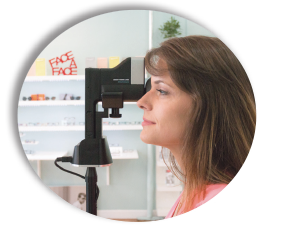
SMART VISION LABS developed the SVOne, an autorefractor powered by wavefront aberrometry, which can store unlimited results on the cloud and prints wirelessly. The company’s mission is to increase access to vision care and also help ECPs grow their practices by leveraging innovation and technology to reduce costs, improve sales and ROI. SVL co-founder and CEO Dr. Yaopeng Zhou remarked, “SVL is taking a different approach to offering a telemedicine refraction exam. By taking measurements including wavefront refraction, visual acuity and pupillary distance, all from a pocket-sized device, SVOne, we are offering an intuitive experience to patients in just a five-minute process. After 120,000 exams with 4 percent remake rate, we believe a Smart Vision exam is a perfect complement to the current subjective refraction approach, when a traditional exam lane is not available.”
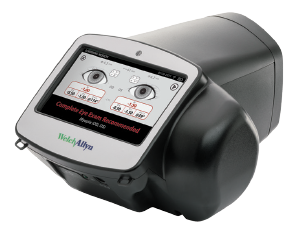
The SPOT VISION SCREENER by WelchAllyn is a handheld autorefractor that screens for refractive error as well as other conditions, measuring horizontal and vertical eye alignment, pupil size and pupillary distance. It supports AAP screening guidelines for early detection of amblyopic risk factors. The device uses lights and sounds to help engage children, connects wirelessly to printers and has both a USB port and Wi-Fi to allow easy export of data. “SPOT helps eyecare professionals differentiate and expand vision care services outside of the office setting (e.g., community/school vision screenings), quickly capturing results on children or adults with pupils as small as 3 mm,” says Kaitlin Lyons, marketing manager for Welch Allyn. SPOT yields results with “proven accuracy compared to desktop autorefractors, in a portable solution that identifies refractive errors and ocular misalignments on any patient, even those with limited mobility or disabilities.”
THE (DOUBLE) BOTTOM LINE
Wondering about that last item on my events packing list—the Minion costume? The bespectacled yellow fellow is a magnet for children at the events we attend—in addition to always making the local paper (in his Metro Optics logo overalls), the draw of interacting and posing for photos, with the popular life-size character is the ideal way to get kids (and their parents) into our vision screening booth. Providing cartoon fun for the kids always attracts more families to engage with us and get screened at outreach events—increasing new patient acquisition as well as retention, and demonstrating our community involvement in a fun, approachable way. Combining free valuable public health services such as eye health education and easy eye testing, along with an Instagrammable fashion and/or entertainment element will help keep your practice top of mind and provide a steady stream of potential new patients.
Contributing editor Sara Bonizio is marketing & community relations manager for Metro Optics Eyewear in the Bronx, N.Y..












